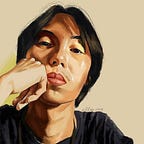Comics Review: 14 by Manix Abrera
There are multiple facets to Manix Abrera as an artist and what fascinates me is the aspect of him that attempts to deconstruct what came before him. On one hand, we have Abrera working on a deadline with a promised punchline at the end of the strip, and this can be seen in his works like KikoMachine Komix and News Hardcore. In those types of texts, more often than not, he relies on dialog to convey his humor. The rare Abrera is the opposite of that: in 12, we have a comic creator who has the space to work with longer stories and intentionally limits himself by never using words (and perhaps to a fault, because while 12 as a concept title is tempting, it is also dull and boring). While 12 is my favorite of the two, neither style is objectively superior, and each one requires a different set of discipline and aesthetics. What is significant about 12, however, is that few local comic creators choose and effectively execute wordless comics on a consistent basis, which is why each attempt seems refreshing and innovative. 14 is the spiritual successor to 12, but rather than simply regurgitating his established formula, Abrera challenges himself to do better.
While not every collection needs to have a theme, the problem with some comic compilations is that the stories seem bereft of aim and direction, or falter when it comes to its central conceit. 12 had a loose theme, with Existentialism being a recurring motif in those strips. 14 has a tighter grip on its agenda, whether it’s the framework of the campfire stories trope, the usage of mythological creatures, or the attempts at black comedy. I wouldn’t say each comic is a flawless success—a few falter in their execution—but even the weakest of the lot is superior to a lot of the published comics out there. Each page and every panel is carefully planned and deliberate, and this refinement elevates the work from satisfactory to great.
For example, one of the best comics in the book is the three-part diwata segment. There’s nothing remarkable per se with the first two chapters, but they are examples of good story fundamentals and how they serve as appetizers for the main course. It’s really the third chapter where Abrera shines, but it relies on the previous chapters to establish the conflict. One of my problems with Abrera’s style is that some of his strips could be illustrated in black and white and their effectiveness would not diminish. That is not the case here as the author goes all out in his depiction of this fantastical landscape reminiscent of epic RPGs like Secret of Mana or Child of Light. It is also one of those rare local comics which portray mothers in the leading role. There is also the employment of The Sims-type dialog to convey the character’s emotions and feelings, and then the deliver of the punchline at the end which sets the tone for the rest of the book.
Another successful endeavor is the shapeshifter chapter as Abrera combines the symmetry of the nine-panel formula with the role of juxtaposition and transition. This isn’t an innovative way of presenting comics, and instead boils down to excellent use of panels and comic strip basics. But because it is handled so well, it shows us that you don’t need to be fancy to make great comics, as long as you have a solid foundation and grasp how to apply the fundamentals.
The challenge of Abrera is sustaining the quality, and when you have a lot of terrific work, the mediocre ones stand out. There is the white lady part for example, and had the shapeshifter scene not preceded it, it would be a good example of the effective use of the nine-panel structure. But since the author already did that—and arguably better—with the previous strip, the punchline at the end falls flat and feels cliched. That’s not to say there is a premium on originality. If we look at the kapre story for example, we have a plot without conflict that is unoriginal. But what carries that particular comic is its execution, at how elements like words and story are artifice, and the power of background, scenery, and imagery is enough to satisfy the reader.
Perhaps the weakest aspect of 14 is its title. It worked for 12, since there were twelve comics in that collection, each one with clear boundaries for its beginning, middle, and end. That’s not quite the case with 14, as we have the framework narrative—our protagonist wandering into a supernatural campfire—in addition to the fourteen comics in the book. And we could argue that fourteen isn’t really fourteen, as the both the diwata and tiyanak sequences represent three comics each. But in the long run, this is a minor complaint to what is a solid book.
The strength of 14 isn’t that it’s a wordless comic, but by placing this constraint on himself, Abrera is able to focus on what makes comics great. And for the most part, he not only succeeds, but does so spectacularly.
